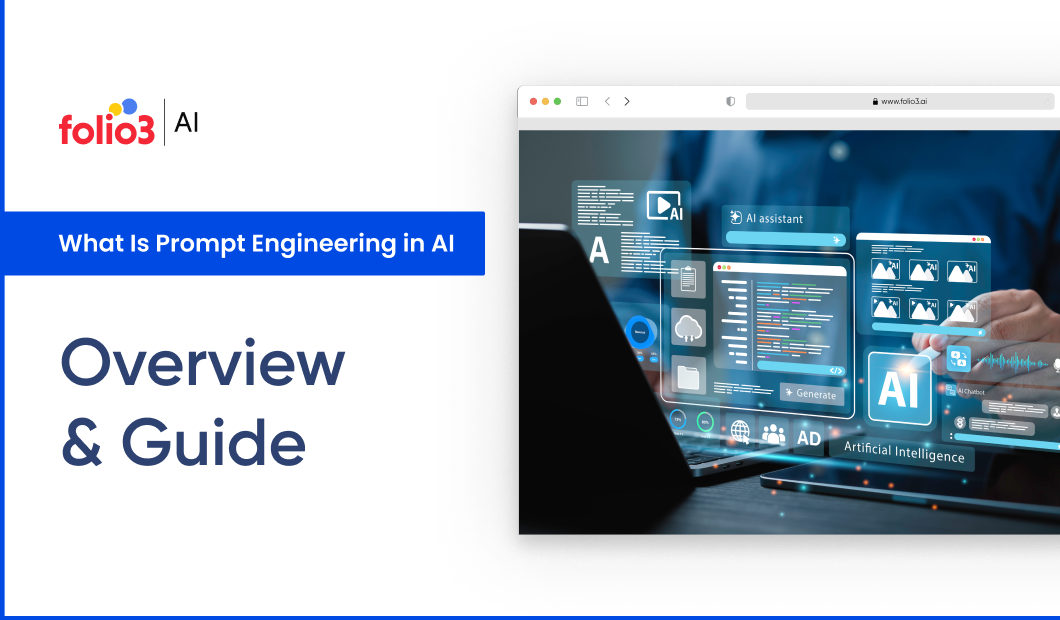Large language models and Generative AI, like GPT, have become the primary resources for insight. However, getting a relevant and quality answer depends on how we communicate with these AI systems.
That’s where “prompt engineering” terminology bridges human intent and machine understanding. It helps you refine your query for chatbots or fine-tune commands for language models. So that AI systems deliver accurate, relevant, and meaningful responses.
This article will examine the importance of prompt engineering growth and the techniques used. And how it enables users to tailor responses for various applications such as content creation, customer service automation, and even software development.
What is Prompt Engineering?
Prompt engineering refers to the practice of designing and refining inputs (prompts) to interact with AI models in a way that produces the most accurate, relevant, and useful responses. It is an essential skill in working with large language models like GPT, as the quality and clarity of a prompt can significantly influence the model’s output.
When we say that a better prompt is necessary for a quality response, we mean that instead of saying, “Tell me about space,” you could refine it to, “Explain the solar system to a 10-year-old with examples of planets and their features.” A well-crafted prompt helps AI systems understand the context and intent behind a query, ensuring outputs align with user expectations.
Why Is Prompt Engineering Important?
Prompt engineering is paramount because it directly influences the quality and relevance of the responses generated by AI models like ChatGPT.
A careful, defined prompt is required from the user to guide the model to produce more accurate, coherent, and contextually appropriate answers. Effective prompts help clarify the user’s intent, allowing the AI to understand the desired outcome better.
This is particularly important in complex tasks, where nuanced and specific information is required. Moreover, well-engineered prompts can minimize misunderstandings and reduce the generation of irrelevant or inaccurate content, ultimately facilitating the overall user experience and making the interaction with AI more productive and efficient.
What Are Some Prompt Engineering Use Cases?
1. Customer Support Automation
You can create prompts to train AI so it can handle customer queries, give personalized responses, and troubleshoot common issues quickly and efficiently. For example, prompts can guide AI to simulate human-like interactions such as “Assist a user facing login issues by providing step-by-step solutions”.
2. Language Translation with Context Awareness
Design prompts that help AI translate text while keeping the tone, context, and cultural nuances intact. A tailored prompt might look like “Translate this marketing slogan into French while keeping it engaging and culturally relevant.”
3. Data Summarization for Quick Insights
Using prompts to condense large datasets, articles, or documents into concise summaries. For instance, “Summarize this 10-page research paper into 200 words, focusing on key findings and their implications.”
What Are Prompt Engineering Techniques?
Prompt engineering techniques are essential for maximizing the effectiveness of AI models, particularly in natural language processing tasks. Here are some key techniques employed in prompt engineering.
1. Zero-Shot Prompting
This technique involves asking the AI to generate a response without providing any examples or prior context. It’s useful for straightforward queries where quick answers are needed.
2. One-Shot Prompting
In this method, the user provides one example to guide the AI’s response, helping it understand the expected format and context.
3. Chain-of-Thought Prompting
This approach breaks down complex questions into smaller, logical parts, allowing the AI to reason through the problem step-by-step. It enhances the model’s ability to tackle intricate issues by focusing on intermediate steps before arriving at a final answer.
4. Self-Refine Prompting
Here, the AI is prompted to critique its own responses and refine them iteratively until a satisfactory solution is reached. This technique encourages deeper analysis and correction of errors.
5. Contextual Prompting
Providing context within prompts helps guide the AI’s understanding of the task. This can include specifying roles (e.g., “act as a technical support specialist”) or detailing the desired tone and style.
6. Hybrid Prompts
Combining various techniques, hybrid prompts may integrate direct instructions with creative challenges, enhancing the AI’s ability to respond effectively to complex requests.
7. Meta-Prompts
These prompts encourage the AI to reflect on its reasoning processes or capabilities, allowing it to adjust its approach based on self-assessment.
8. Complexity-Based Prompting
This involves selecting responses from multiple chain-of-thought rollouts, focusing on those with more detailed reasoning processes to ensure comprehensive answers.
What Are Some Prompt Engineering Best Practices?
These practices are necessary, So you can optimize the AI performance and improve the relevance and accuracy of its outputs. Here are some key best practices for prompt engineering.
1. Be Clear and Unambiguous
Ensure that the prompt is straightforward and free from vagueness to avoid any confusion or misinterpretation by the AI.
2. Provide Sufficient Context
The more context you provide, the better the AI can understand the intent and generate more relevant responses.
3. Keep It Simple and Concise
Avoid overloading the prompt with unnecessary details. Focus on what’s essential to achieve the desired output.
4. Experiment and Refine
Test different variations of your prompts and refine them based on the responses you get. Iteration is key to optimizing prompts.
5. Be Specific with Instructions
When asking for a particular format or style, include clear instructions so the AI knows exactly what to do.
6. Use Clear and Direct Language
Avoid complex or ambiguous words, as simple and direct language helps the AI interpret the prompt more effectively.
7. Test with Edge Cases
To ensure robustness, test your prompt across a variety of scenarios, including edge cases, to see how the AI responds.
Benefits of Prompt Engineering
- Improved Accuracy: Clear and specific prompts lead to more accurate and relevant responses.
- Enhanced Efficiency: Reduces the need for multiple revisions by getting closer to the desired output with minimal adjustments.
- Consistency in Results: Well-defined prompts generate consistent outcomes across different tasks and scenarios.
- Time-Saving: By refining and iterating on prompts, you can save time in obtaining high-quality results without excessive trial and error.
- Better Context Understanding: Providing sufficient context helps the AI to grasp nuances and deliver more contextually appropriate responses.
- Optimized AI Performance: Well-constructed prompts improve the AI’s ability to generate high-quality, relevant information tailored to your needs.
Strategies for Writing Relevant Prompts
It’s understandable that you might need to understand what prompts will produce better work. So here are some effective approaches to writing for reliable outcomes when working with AI models. This table can serve as a handy guide to crafting more effective and targeted AI prompts.
| Strategy | Description | Example |
| Be Clear and Specific | Avoid ambiguity by providing precise details and context. | Explain the applications of AI in healthcare. |
| Define the Context | Give background information to guide the AI’s response and focus. | Write a professional email about a project deadline extension, emphasizing the importance of communication. |
| Use the Right Level of Detail | Decide on the complexity and detail required for the task. | Detailed: “Summarize the article with key findings and potential impact.”Simple: “Summarize the article.” |
| Ask for Structure or Format | Specify the desired structure for the response, such as bullet points or paragraphs. | Write a 3-paragraph summary of the book ‘1984’, highlighting plot, themes, and character development. |
| Use Examples to Clarify Expectations | Provide sample responses to guide the AI’s approach. | Write a poem in Shakespeare’s style about the seasons. Example: ‘Shall I compare thee to a summer’s day? |
| Break Complex Prompts into Smaller Parts | Split larger tasks into simpler sections for more focused responses. | First, list key events in the story. Then, explain the protagonist’s motivations. |
| Use Constraints | Set limits such as word count or specific stylistic guidelines. | Write a 200-word blog post on AI in education with a professional and informative tone. |
| Use Action-Oriented Language | Frame the prompt to encourage specific actions from the AI. | Analyze the following data set and identify key trends. |
| Iterate and Refine | Refine and adjust the prompt if the first attempt doesn’t meet expectations. | Create a marketing campaign for a new product focusing on social media strategies.” (Refine based on feedback.) |
Conclusion
Prompt engineering is a powerful tool for optimizing AI interactions. Improving model performance, reducing bias, enhancing control, and elevating the user experience ensure that AI systems deliver more accurate, reliable, and relevant outputs. Crafting well-designed prompts is essential for unlocking AI’s full potential, ultimately benefiting both developers and users alike. As the use of LLM models increases and is integrated into businesses, it is better to grasp how to write quality prompts.

Manahil Samuel holds a Bachelor’s in Computer Science and has worked on artificial intelligence and computer vision She skillfully combines her technical expertise with digital marketing strategies, utilizing AI-driven insights for precise and impactful content. Her work embodies a distinctive fusion of technology and storytelling, exemplifying her keen grasp of contemporary AI market standards.









